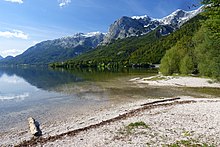Lake Grundlsee
Lake Grundlsee is situated at the southern foot of the Totes Gebirge in Austria, in the Styrian part of the Salzkammergut.
Its location, situated in a beautiful setting, has made it an important tourist destination and a popular bathing lake, as well as a diving and sailing area.
Like the Zimitzbach stream, the latter created a small, now populated delta into the lake in the vicinity of the district of Schachen.
[3][4] The Grundlsee is located on the southwestern edge of the Toten Gebirge formation, which is part of the Northern Limestone Alps.
The Haselgebirge mountains also occur on the southern shore near Vienna, where Saint-Gobain Rigips Austria mines the largest gypsum deposit in the Eastern Alps.
[2] The ice-age Grundlsee local glacier, which originated from the high plateau of the Totes Gebirge and flowed into the Aussee basin, also followed the fault-induced zone of weakness.
The lake area was originally larger and extended from the Toplitz to the Kammersee during the late Würm glacial period.
In the post-glacial period, the lake basin underwent constant change due to sedimentation, and it will likely have disappeared again in a few tens of thousands of years.
[2][5] The Central Institution for Meteorology and Geodynamics in Bad Aussee, situated 3 km away, provides precise data for Lake Grundlsee.
Due to the frequent accumulation of clouds on the edge of the Totes Gebirge, above-average precipitation falls in the area of Lake Grundlsee.
Due to the discharge of untreated wastewater, a trend towards eutrophication was observed in the 1960s, with the oxygen saturation above ground already showing signs of decline.
The oxygen situation improved rapidly, and the oligotrophic state of the lake could be maintained in the long term.
The crustacean plankton of Lake Grundlsee is largely composed of the species Eudiaptomus gracilis, Cyclops abyssorum, Daphnia hyalina, and Eubosmina longispina.
[8] The aquatic flora of the lake is particularly diverse due to the alternation of stony and sandy-muddy, richly structured shore areas.
The Danube bleak (Chalcalburnus chalcoides), which lives in the lake, is a protected species under the Habitats Directive and migrates to the Toplitz and Stimitz creeks during the spawning season.
To create additional spawning grounds for this and other species, the Stimitz estuary was renaturalized in 2016 and an oxbow was opened to restore the connection to the lake.
The perch (Perca fluviatilis) was not originally native to the lake but was introduced at the end of the 1980s for unknown reasons.
As an alien species, it changed the aquatic ecosystem and damaged the population of minnows and arctic char, on whose spawn it feeds.
The largest lake trout ever caught weighed 27 kg and is on display in the Grundlsee town hall.
During the Daffodils Festival, which lasts several days at the end of May/beginning of June, there is a boat parade on the lake every third year.
Under stable, fair weather conditions, the warming of the mountain massif in the northeast creates a vertical current in the early afternoon, which is fed by cool air from the western outflow into the basin in the east.
Grundlsee is the starting point for several hiking trails: The Enns Valley was a settlement area of the Alpine Slavs and many place names are of Slavic origin.
[22] The name of the stream that flows into it, the Toplitzbach, comes from the Slavic toplica, meaning warm spring water.
As with all the lakes in the inner Salzkammergut, there was also a splash dam for timber rafting at the outlet of the Grundlsee, where large quantities of water could be stored with relatively few resources.
To reduce the high consumption of wood due to the frequent construction of new buildings, important hermitages were rebuilt with stone blocks in the middle of the 18th century as part of the reforms of Salzamtmann Freiherr von Sternbach.
During World War II, Ausseer Land and Grundlsee were part of the Alpine Fortress and a retreat for the National Socialists.
Villa Roth, used as a summer residence by Joseph Goebbels and his family, is located on the northeastern shore.
From 1943 to 1945, the villa was the official office of the Chemical and Physical Research Institute of the Navy (CPVA), which maintained an experimental station on Lake Toplitz.
In your mountains lies the kernel; it runs salty and smokes at the two sea traunas!During the Biedermeier period, landscape painters came to the Salzkammergut and Lake Grundlsee.
Rudolf von Alt, Conrad Kreuzer, and Ferdinand Georg Waldmüller created paintings of the lake and its surroundings.









